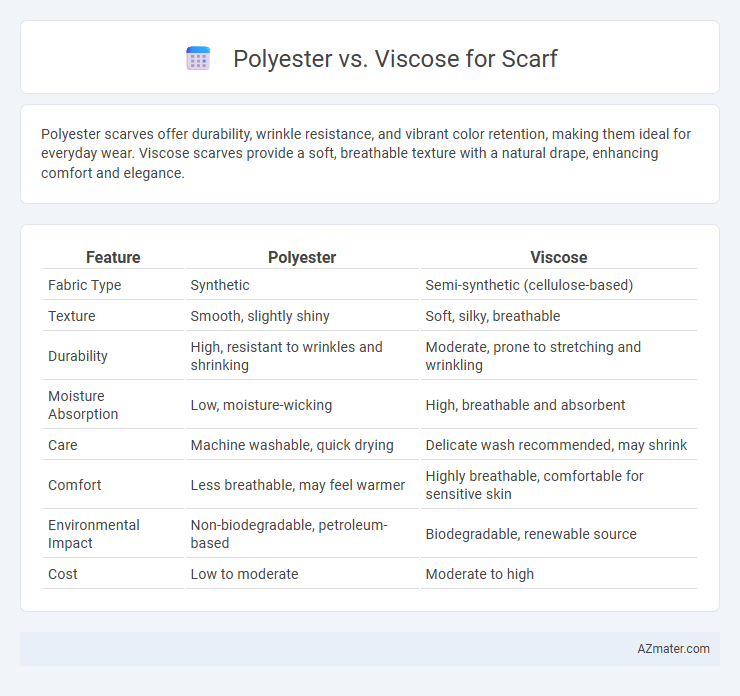Polyester scarves offer durability, wrinkle resistance, and vibrant color retention, making them ideal for everyday wear. Viscose scarves provide a soft, breathable texture with a natural drape, enhancing comfort and elegance.
Table of Comparison
| Feature | Polyester | Viscose |
|---|---|---|
| Fabric Type | Synthetic | Semi-synthetic (cellulose-based) |
| Texture | Smooth, slightly shiny | Soft, silky, breathable |
| Durability | High, resistant to wrinkles and shrinking | Moderate, prone to stretching and wrinkling |
| Moisture Absorption | Low, moisture-wicking | High, breathable and absorbent |
| Care | Machine washable, quick drying | Delicate wash recommended, may shrink |
| Comfort | Less breathable, may feel warmer | Highly breathable, comfortable for sensitive skin |
| Environmental Impact | Non-biodegradable, petroleum-based | Biodegradable, renewable source |
| Cost | Low to moderate | Moderate to high |
Introduction to Polyester and Viscose Scarves
Polyester scarves offer durability, resist wrinkles, and maintain vibrant colors due to their synthetic fiber composition, making them ideal for everyday wear. Viscose scarves, made from regenerated cellulose fibers, provide a soft, breathable texture that mimics natural silk's smoothness and drape. Both materials cater to different preferences, with polyester excelling in longevity and easy care, while viscose emphasizes comfort and a luxurious feel.
What is Polyester?
Polyester is a synthetic fiber made from petroleum-based compounds, known for its durability, wrinkle resistance, and quick-drying properties. Its ability to retain vibrant colors and resist shrinking makes it a popular choice for scarves that require easy maintenance and long-lasting wear. Compared to natural fibers, polyester scarves offer enhanced strength and affordability, making them suitable for everyday fashion accessories.
What is Viscose?
Viscose is a semi-synthetic fiber made from regenerated cellulose sourced primarily from wood pulp, known for its softness, breathability, and silky texture. Unlike polyester, which is a fully synthetic fiber derived from petroleum, viscose offers a more natural feel and better moisture absorption, making it ideal for scarves that require comfort against the skin. Its ability to drape well and take vibrant dyes also enhances the aesthetic appeal of viscose scarves compared to polyester versions.
Softness and Feel: Polyester vs Viscose
Viscose scarves offer a soft, silky feel that closely resembles natural fibers, providing a comfortable and breathable experience ideal for sensitive skin. Polyester scarves, while less breathable, are typically smoother and more resilient, maintaining softness after multiple washes without pilling. Choosing between the two depends on preference for natural-like softness and moisture absorption in viscose, versus the durability and wrinkle resistance of polyester.
Durability and Longevity Comparison
Polyester scarves exhibit superior durability due to their resistance to stretching, shrinking, and wrinkling, making them ideal for frequent use and long-term wear. Viscose scarves, while offering a soft and breathable texture, tend to degrade faster with repeated washing and exposure to moisture, which can shorten their lifespan. Overall, polyester scarves provide enhanced longevity compared to viscose, maintaining shape and color integrity over extended periods.
Breathability and Comfort for Scarves
Viscose offers superior breathability compared to polyester, making it ideal for scarves worn in warmer weather due to its natural moisture-wicking properties. Polyester, while durable and wrinkle-resistant, tends to trap heat and moisture, reducing overall comfort during extended wear. Choosing viscose scarves enhances airflow and softness, providing a lightweight, comfortable feel against the skin.
Color Vibrancy and Print Quality
Polyester scarves exhibit superior color vibrancy and print quality due to their synthetic fibers, which hold dyes more effectively and resist fading over time. Viscose, while offering a soft and luxurious feel, tends to absorb dye unevenly, leading to less vivid colors and print details that may blur with repeated washing. Choosing polyester ensures bold, long-lasting patterns ideal for scarves intended to maintain sharp, colorful designs.
Care, Maintenance, and Washability
Polyester scarves are highly durable, resistant to wrinkles, and machine washable, making them low-maintenance and easy to care for. Viscose scarves require gentle hand washing or dry cleaning to maintain their softness and prevent shrinkage or damage due to their delicate fibers. Polyester holds up better to frequent washes and exposure to sunlight, while viscose demands more careful handling to preserve texture and color vibrancy.
Sustainability and Eco-Friendliness
Polyester scarves, made from synthetic fibers derived from petroleum, have a significant environmental impact due to non-biodegradability and energy-intensive production processes. Viscose, a semi-synthetic fiber produced from cellulose in wood pulp, offers a more biodegradable and renewable alternative, but its sustainability depends on sourcing practices and chemical processing methods involved. Choosing scarves made from certified organic or responsibly sourced viscose supports eco-friendliness, while recycled polyester options reduce waste yet still pose long-term environmental challenges.
Which is Better for Scarves: Polyester or Viscose?
Polyester scarves offer durability, wrinkle resistance, and vibrant color retention, making them ideal for long-lasting fashion accessories. Viscose scarves provide a soft, breathable texture with a natural feel, enhancing comfort and breathability especially in warmer weather. Choosing between polyester and viscose depends on whether durability and colorfastness or softness and breathability are prioritized for scarf use.

Infographic: Polyester vs Viscose for Scarf
 azmater.com
azmater.com